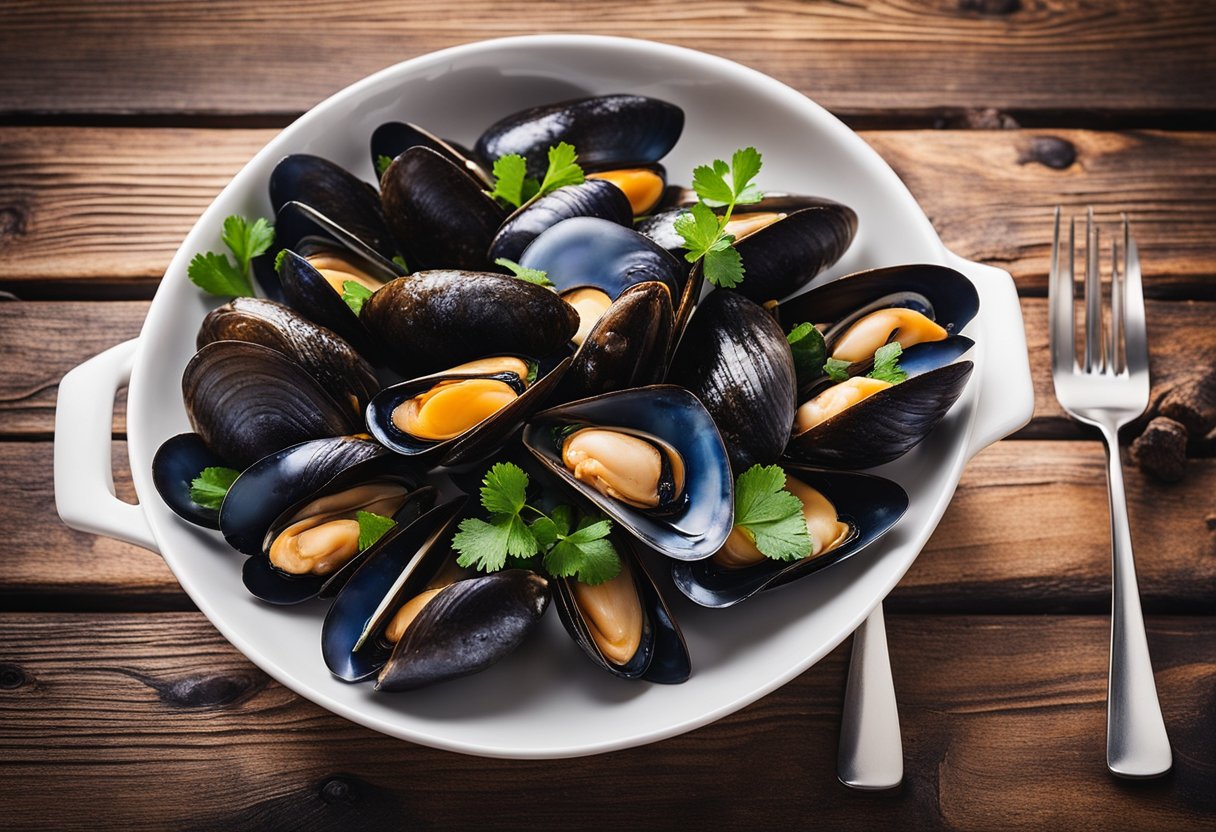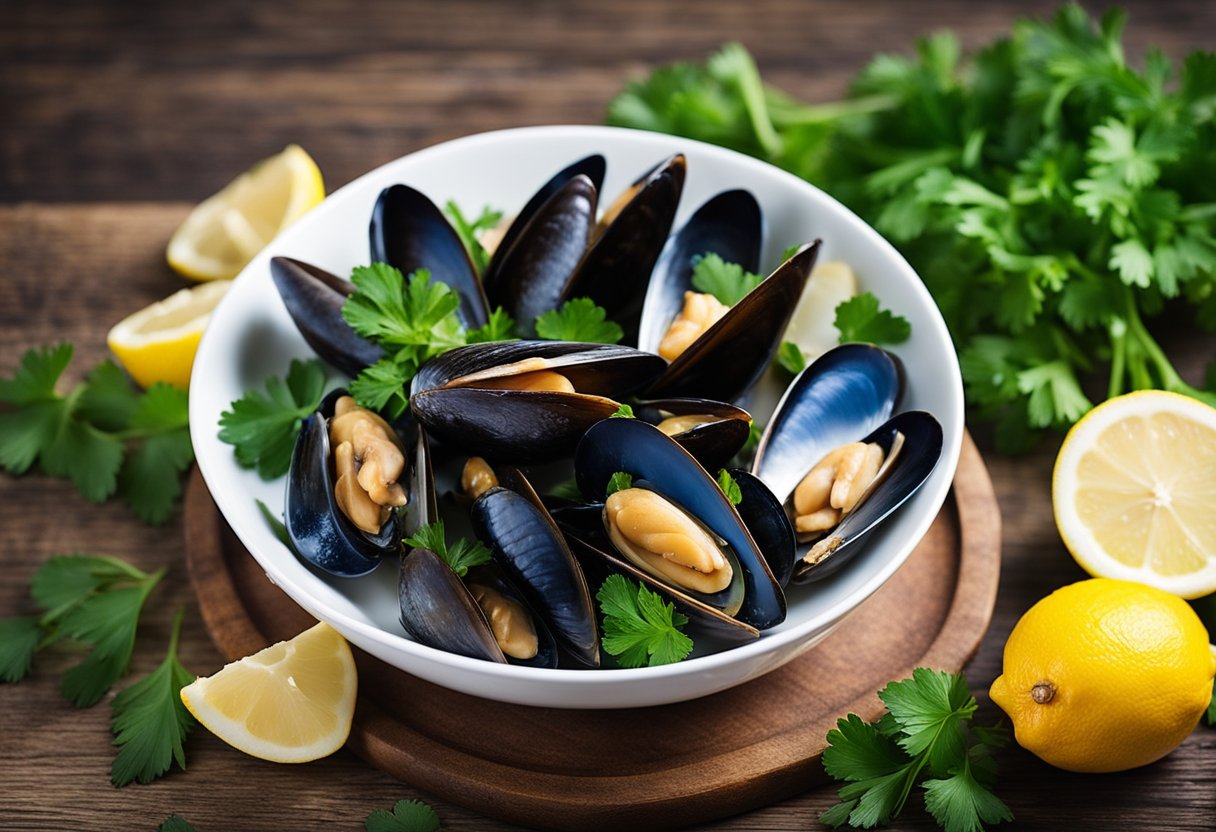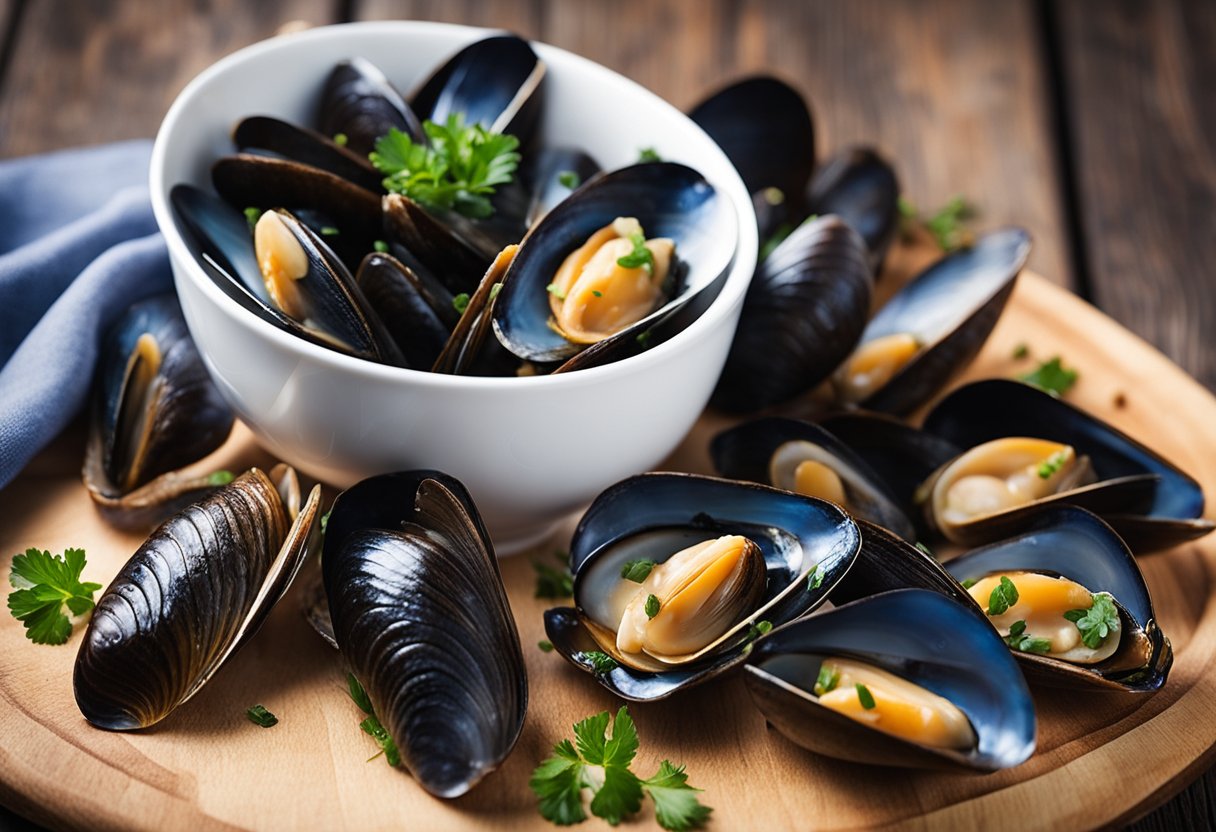As a seafood lover, I know how frustrating it can be to have leftover mussels that need reheating. But reheating mussels can be a bit tricky, and if not done properly, it can lead to a loss of flavor and texture.
In this article, I will share with you the best ways to reheat mussels so that you can enjoy them just as much as when they were first cooked.

Understanding mussels is an essential part of reheating them. Mussels are a type of shellfish that are high in protein, omega-3 fatty acids, and other nutrients. They are usually cooked in a broth or sauce, which gives them their distinctive flavor.
When reheating mussels, it is important to keep them moist and avoid overcooking them. With that in mind, let’s dive into the best ways to reheat mussels.
Key Takeaways
- Reheating mussels can be tricky, but it is important to keep them moist and avoid overcooking them.
- The best ways to reheat mussels are on the stove, in the microwave, or in the oven.
- To incorporate mussels into dishes, add them at the end of the cooking process to avoid overcooking them.
Understanding Mussels

As a seafood lover, I find mussels to be a delicacy that is both tasty and healthy. Mussels are a type of shellfish that are found in both freshwater and saltwater environments. They are a great source of protein, iron, and vitamin B12, making them a nutritious addition to any diet.
Mussels are typically harvested from the wild, but they can also be farmed. They are filter feeders, which means they feed on plankton and other microscopic organisms that are present in the water. This makes them an eco-friendly choice for seafood lovers.
When purchasing mussels, it is important to look for fresh ones. Fresh mussels should be tightly closed, and they should smell like the ocean. If they are open or have a strong fishy smell, they may be spoiled and should be avoided.
Mussels are typically cooked by steaming or boiling them in a flavorful liquid, such as wine or broth. They can also be baked or grilled. When cooked properly, mussels should be plump and tender, with a sweet and briny flavor.
It is important to note that leftover cooked mussels should be reheated carefully to prevent them from becoming tough and chewy. The best way to reheat mussels is in a sauce or broth, or by baking them in the oven. Avoid reheating them in the microwave, as this can cause them to become rubbery.
In summary, mussels are a delicious and nutritious seafood option that can be enjoyed in a variety of ways. When purchasing and cooking them, it is important to ensure that they are fresh and properly cooked to avoid any health risks.
Preparing for Reheating
Before reheating mussels, it’s important to properly store them in the fridge in an airtight container. Leftover mussels can be stored in the fridge for up to 2 days. If you plan on reheating frozen mussels, you will need to thaw them first by placing them in the fridge overnight.
When preparing to reheat mussels, it’s important to make sure they are still fresh and safe to eat. Check the mussels for any signs of spoilage or open shells that don’t close when tapped. Discard any mussels that are not fresh or safe to eat.
When reheating mussels, there are a few different methods you can use, such as steaming, pan-frying, or reheating in a sauce or broth. The best method will depend on your personal preference and the recipe you are using.
If you are reheating mussels in a sauce or broth, it’s important to heat the sauce or broth slowly in a saucepan until it’s piping hot. Once it’s hot, remove it from the heat and add the mussels. Let the mussels warm for 1-2 minutes before serving.
Overall, properly preparing and storing leftover mussels is crucial for safe reheating. Whether you are reheating fresh or frozen mussels, make sure to follow the appropriate steps for thawing and reheating to ensure a delicious and safe meal.
Reheating Mussels on the Stove
When reheating mussels on the stove, there are a few things to keep in mind to ensure they come out perfectly heated and delicious. Here’s how I do it:
- Start by removing the mussels from their shells and placing them in a bowl. This will help them heat more evenly and prevent them from drying out.
- In a separate pot, heat up some broth or soup. You can use any type of broth or soup you like, but I prefer to use a seafood or vegetable broth to complement the flavor of the mussels. If you have leftover broth from when you originally cooked the mussels, you can use that too.
- Once the broth is heated, add the mussels to the pot. If you prefer, you can also add some white wine to the broth for extra flavor.
- Cover the pot with a lid and let the mussels steam for 5-7 minutes, or until they are heated through. Be careful not to overcook them, as this can cause them to become tough and chewy.
- Once the mussels are heated through, remove them from the pot and serve immediately. You can garnish them with some fresh herbs or lemon wedges for extra flavor.
Reheating mussels on the stove is a quick and easy way to enjoy leftover mussels. By following these simple steps, you can ensure that your mussels are perfectly heated and full of flavor.
Reheating Mussels in the Microwave
When it comes to reheating mussels, the microwave can be a quick and easy option. However, it’s important to do it correctly to ensure that the mussels are safe to eat and retain their flavor and texture.
Firstly, you need to make sure that the mussels are in a microwave-safe dish. Glass or ceramic dishes are ideal, but make sure to avoid plastic containers as they can release harmful chemicals when heated.
To prevent the mussels from drying out, add a small amount of liquid such as water, wine, or broth to the dish. Cover the dish with a microwave-safe lid or plastic wrap, leaving a small vent for steam to escape.
Next, microwave the mussels on high for 30-second intervals, checking and stirring them in between each interval. The exact time will depend on the amount of mussels and the power of your microwave, but it typically takes 1-2 minutes to reheat a small portion.
Once the mussels are heated through, remove them from the microwave and let them sit for a minute or two before serving. This will allow the heat to distribute evenly and ensure that the mussels are safe to eat.
Overall, reheating mussels in the microwave can be a convenient option if done correctly. Just make sure to use a microwave-safe dish, add liquid to prevent drying, and heat in short intervals while checking and stirring frequently.
Reheating Mussels in the Oven
When it comes to reheating mussels, the oven is a great option. Not only does it heat them evenly, but it also helps to retain their moisture and flavor. Here’s how I like to reheat baked or breaded mussels in the oven:
- Preheat your oven to 375°F.
- Place your leftover mussels in an oven-safe dish.
- Add a small amount of butter or garlic butter to the dish to help keep the mussels moist.
- Cover the dish with aluminum foil.
- Bake the mussels in the oven for 10-15 minutes or until they are heated through.
Be sure to check on the mussels occasionally to make sure they don’t overcook and dry out. You can also add additional seasonings or toppings to the mussels before baking, such as breadcrumbs or Parmesan cheese.
Overall, reheating mussels in the oven is a simple and effective way to enjoy your leftovers. Just be sure to use an oven-safe dish and keep an eye on the mussels while they bake.
Incorporating Mussels into Dishes

When it comes to incorporating mussels into dishes, the possibilities are endless. Mussels can be used in a variety of dishes, from appetizers to seafood dishes, and even in pasta sauce or chowder. Here are some ideas on how to incorporate mussels into your dishes.
Appetizer
Mussels make for a great appetizer. To prepare, simply steam the mussels and serve with a side of crusty bread. For added flavor, you can also serve them with a dipping sauce, such as a garlic butter sauce or a tomato-based sauce.
Pasta Sauce
Mussels can also be incorporated into pasta sauce for a delicious seafood twist. To do this, cook your favorite pasta and set it aside. In a separate pan, sauté garlic and onions in olive oil until they are translucent.
Add in diced tomatoes and cook until they are soft. Then, add in the mussels and cook until they are heated through. Pour the sauce over the pasta and serve.
Chowder
Mussels can be used in a creamy chowder for a hearty and delicious soup. To make the chowder, sauté onions and garlic until they are soft. Add in diced potatoes and cook until they are soft.
Then, add in chicken or vegetable broth and bring to a boil. Add in the mussels and cook until they are heated through. Finally, add in heavy cream and stir until the chowder is creamy.
Seafood Dish
Mussels can also be used in a variety of seafood dishes, such as paella or cioppino. To incorporate mussels into a seafood dish, simply add them in with other seafood, such as clams or shrimp. Cook the dish as you normally would, and enjoy the delicious flavors of the mussels.
Overall, mussels are a versatile ingredient that can be used in a variety of dishes. By incorporating mussels into your cooking, you can add a delicious seafood twist to your favorite recipes.
Storing and Freezing Cooked Mussels
As much as we love mussels, sometimes we can’t finish them all in one sitting. So, what do you do with the leftovers? Here are some tips on how to store and freeze cooked mussels.
Storage
If you have leftover cooked mussels, store them in an airtight container in the refrigerator. Make sure to remove the mussels from their shells and place them in a shallow container.
This will help them cool down quickly and prevent the growth of bacteria. You can store cooked mussels in the refrigerator for up to two days.
Freezing Cooked Mussels
If you’re not planning on eating your leftover mussels within two days, you can freeze them. Freezing cooked mussels is a great way to extend their shelf life. Here’s how to do it:
- Remove the mussels from their shells and place them in a freezer-safe container.
- Cover the mussels with their cooking liquid or broth. This will help keep them moist and prevent freezer burn.
- Label the container with the date and contents.
- Place the container in the freezer.
Frozen cooked mussels can last up to three months in the freezer. When you’re ready to eat them, thaw the mussels in the refrigerator overnight. Once thawed, you can reheat them using your preferred method.
Frozen Mussels
If you have raw mussels that you want to freeze, you can do that too. Here’s how:
- Clean and debeard the mussels.
- Rinse the mussels in cold water and pat them dry with a paper towel.
- Place the mussels in a freezer-safe container or bag.
- Label the container or bag with the date and contents.
- Place the container or bag in the freezer.
Frozen raw mussels can last up to six months in the freezer. When you’re ready to cook them, thaw the mussels in the refrigerator overnight. Once thawed, you can cook them using your preferred method.
In conclusion, storing and freezing cooked mussels is a great way to prevent food waste and extend their shelf life. By following these simple steps, you can enjoy your favorite seafood dish anytime you want.
Safety Considerations
When it comes to reheating mussels, there are a few safety considerations to keep in mind to ensure that you don’t get sick from eating them. As someone who has worked in the food industry for several years, I have learned a lot about food safety and how to prevent foodborne illness.
Firstly, it is important to note that if you have any doubts about the safety of your mussels, it is better to err on the side of caution and throw them away.
Mussels that have been left out at room temperature for too long or have been stored improperly can be a breeding ground for harmful bacteria that can cause food poisoning.
When reheating mussels, it is important to make sure that they are heated to a safe temperature of at least 165°F (74°C). This will kill any bacteria that may be present and make the mussels safe to eat.
You can use a food thermometer to check the temperature of the mussels to ensure that they are heated to the proper temperature.
It is also important to handle the mussels properly when reheating them. Make sure to wash your hands thoroughly before and after handling the mussels to prevent the spread of bacteria. Avoid using the same utensils or cutting boards that were used for raw seafood to prevent cross-contamination.
When storing leftover mussels, it is important to refrigerate them promptly and to use them within 1-2 days. Leftover mussels that have been stored in the fridge for too long can also be a breeding ground for harmful bacteria.
In conclusion, reheating mussels can be done safely as long as you take the proper precautions. Always make sure to heat the mussels to a safe temperature, handle them properly, and store them promptly in the fridge.
By following these safety considerations, you can enjoy your leftover mussels without worrying about getting sick.
Tips for Best Results

As someone who loves seafood, I know how important it is to reheat mussels correctly. Here are some tips that have helped me achieve the best results:
- Remove the mussels from their shells: Before reheating, it’s best to remove the mussels from their shells. This will prevent them from drying out and becoming tough. Plus, it makes it easier to reheat them in different ways.
- Reheat in a moist environment: Mussels are best reheated in a moist environment to prevent them from drying out. You can reheat them in a broth or sauce, or even in the microwave with a damp paper towel over them.
- Don’t overcook: Mussels are already cooked, so you don’t want to overcook them when reheating. Overcooking can cause them to become rubbery and tough. Instead, reheat them just until they are heated through.
- Use the right method: There are several methods for reheating mussels, such as steaming, pan-frying, or microwaving. Choose the method that works best for you based on the time and equipment you have available.
- Add flavor: Mussels can be reheated on their own, but adding some extra flavor can make them even better. Try adding garlic, butter, or herbs to your broth or sauce for a delicious twist.
By following these tips, you can reheat your mussels to perfection every time.
Frequently Asked Questions

Is it safe to reheat cooked mussels?
Yes, it is safe to reheat cooked mussels as long as they have been stored properly and reheated to the correct temperature. It is important to reheat them to an internal temperature of at least 165°F (74°C) to kill any bacteria that may have grown on them.
Can you reheat cooked mussels more than once?
No, it is not recommended to reheat cooked mussels more than once. Reheating them multiple times can increase the risk of bacterial growth and food poisoning.
What is the best way to reheat mussels in broth?
The best way to reheat mussels in broth is to heat the broth slowly in a saucepan and once it’s piping hot, remove it from the heat and add the mussels. Let the mussels warm for 1-2 minutes before eating.
How can I reheat mussels without overcooking them?
To reheat mussels without overcooking them, you can steam them by placing them in a steamer basket over boiling water for a few minutes until heated through. Another option is to pan-fry them in a bit of butter or oil until heated through.
What is the recommended method for reheating mussels in marinara sauce?
The recommended method for reheating mussels in marinara sauce is to heat the sauce slowly in a saucepan and once it’s piping hot, remove it from the heat and add the mussels. Let the mussels warm for 1-2 minutes before serving.
Can you safely reheat mussels in the microwave?
Yes, you can safely reheat mussels in the microwave, but it is important to reheat them on low power and in short intervals of 15-20 seconds at a time. Check after every round to avoid overcooking them.
